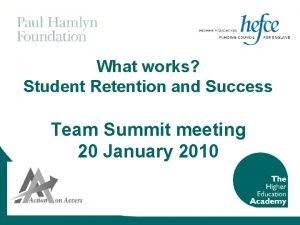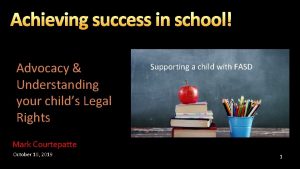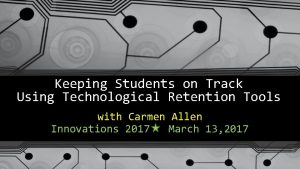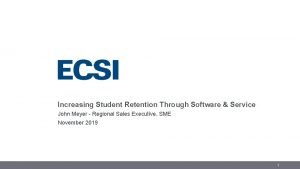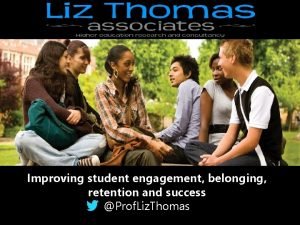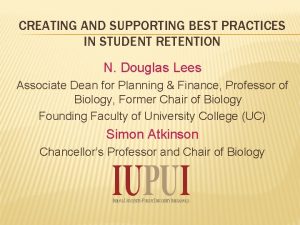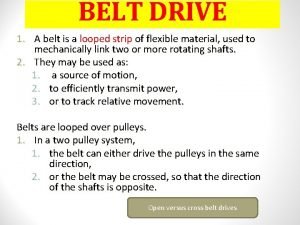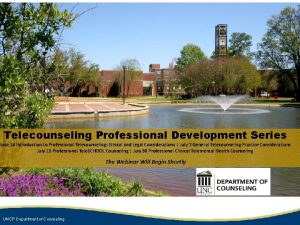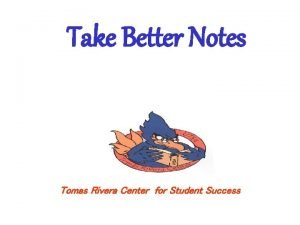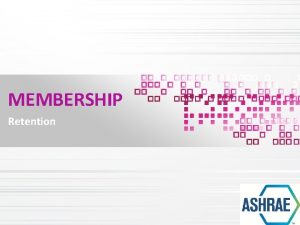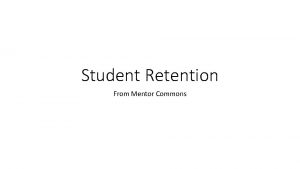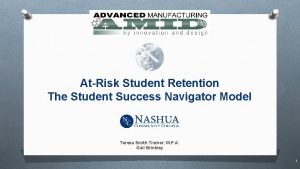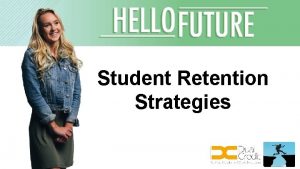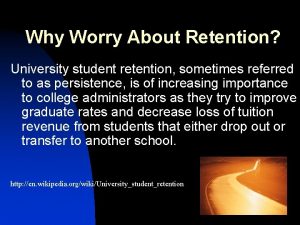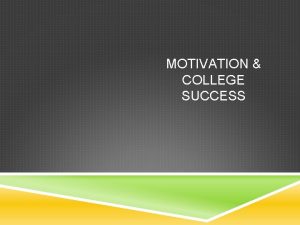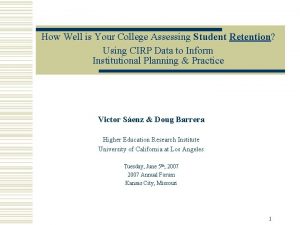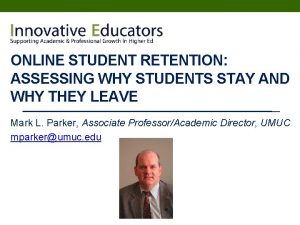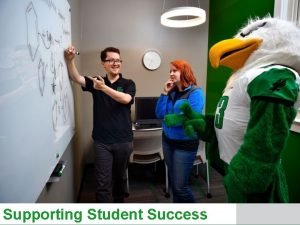Assessing Student Success Initiatives to Drive Campus Retention


















- Slides: 18

Assessing Student Success Initiatives to Drive Campus Retention Efforts Marisa Passafiume Manhattan College

Student Success Initiatives -Tutoring & Supplemental Instruction -English language instruction -Early Alert/ System of referrals -Opportunity Programs -Advising for student athletes -Support for students with learning differences

What do we want to assess? Approach this as a TEAM What is it you want to show/prove to your stakeholders? Quantitative……AND qualitative Keep is simple Come full circle (it starts with your annual goals, and ends with your annual report) • Thinking 3 years out…… • • •

Every assessment goal should…. • Be tied to student learning • Be tied to student satisfaction • Support retention

The “HOW TO”…. .

Assessing academic support services Quantitative – MACRO Quantitative - MICRO • #of unique students accessing academic support (tutoring, SI, ELI, Peer Academic Coaching) every semester • #of tutoring sessions facilitated every semester • SI attendance • Specific course DFWI rates • Individual students grades (pre/post midterm) • Students on academic probation semester to semester • DFWI rates (by course & faculty *remain consistent*) • Grade distribution by student

Assessing Academic Support Services: Qualitative • Student satisfaction (surveys) • MAPworks (student survey)

Goal #2: Ensure the seamless transition to the new CAS and in doing so improve student success, retention, and satisfaction.

Goal #2: Measure 1 • Measure #1: Facilitation of pre-Fall 2016 training for all CAS Staff • Summary of finding: The CAS organized and executed a pre. Fall 2016 training for all new and returning student employees on August 26, 2016. • Action plan in response: We will continue to facilitate pre-Fall semester trainings for all new and returning staff and revisit training day content. • Determination of completion: MET • Documentation: Fall 2016 Training Day Agenda [attached] • Documentation: Training Day Attendance Payroll Report FA 16 [attached] • Documentation: Training Day FA 16 Group Photograph [attached]

Goal #2: Measure 2 • Measure #2: Monitor Academic Coaching attendance through our online learning management software, Accudemia • Summary of finding: The CAS consistently used Accudemia software to track student attendance for Academic Coaching during the 2016 -2017 academic year. We exceeded our "expected result" of increasing traffic to 50 students; 98 unique students utilized the Academic Coaching service this year. • Action plan in response: We will continue to use Accudemia to track student attendance for Academic Coaching and we will use this traffic data to drive programmatic decisions. • Determination of completion: EXCEEDED • Documentation: Accudemia report - Academic Coaching 20162017 [attached]

Goal #2: Measure 3 • Measure #3: Monitor tutoring attendance through our online learning management software, Accudemia • Summary of finding: During the 2016 -2017 academic year, we consistently used our Accudemia software to track student attendance for tutoring in the Learning Commons, Writing Center, and Leo Learning Center. We exceeded our “expected result” of increasing traffic to 750 students; 893 unique students utilized CAS tutoring services this year. • Action plan in response: While satisfied with completion of the goal, we plan to pilot the mobile app, Tu. LI, to make tutoring appointments even more accessible to the student body. • Determination of Completion: EXCEEDED • Documentation: Accudemia Report - Total Students Tutored 1617 AY [attached]

Goal #2: Measure 4 • Measure #4: SI partnered courses had DFWI rates of 25% or below • Summary of finding: The average DFWI rate amongst courses that participated in SI were all below 25%. Although, certain individual sections with particular faculty in PHYS were above the 25% rate with high 'W' frequencies. Certain individual sections of courses in BIOL 112 saw DFWI rates so low that they probably do not warrant continued SI service. • Action plan in response: We will continue partnerships in courses with DFWI rates over 15% and reevaluate partnerships in courses with DFWI rates lower than 15%. We expect that with upcoming changes to the PHYS faculty that individual section DFWI rates will decline. • Determination of Completion: MET • • • Documentation: SI DFWI Analysis Spreadsheet PHYS 101 [attached] PHYS 102 [attached] BIOL 112 [attached] MATH 186 [attached] CHEM 102 [attached] HIST 150 [attached] HIST 152 [attached]

Attachment example: Individual Student Analysis (pre & post referral)

Attachment example: Survey results…the good, the bad, the truth!

Attachment example: Grade Distribution by Course (MICRO)

MAPworks • • • Early Alert Referrals Systemic- Campus wide! The algorithm Our focus on the color!

Retention • • • Freshman to Sophomore Commuter vs. Residential First generation PELL recipients Underserved populations

Parting thoughts…. • • The process is as important as the product TEAM approach The vision! Don’t be afraid of “bad data”
 What works student retention and success
What works student retention and success Googlehttps://drive.google.com/drive/my-drive
Googlehttps://drive.google.com/drive/my-drive Google docs powerpoint
Google docs powerpoint гугл диск
гугл диск Your child's success or lack of success
Your child's success or lack of success Your child's success or lack of success
Your child's success or lack of success Student retention tools
Student retention tools John meyer pittsburgh pa
John meyer pittsburgh pa A sense of belonging improving student retention
A sense of belonging improving student retention Best practices in student retention
Best practices in student retention Https drive google com file d 1zphjwy1qqf1g
Https drive google com file d 1zphjwy1qqf1g Https drive google com
Https drive google com Difference between open belt drive and cross belt drive
Difference between open belt drive and cross belt drive Cross belt drive
Cross belt drive Mpgu
Mpgu Cecile barbier
Cecile barbier Hixson lied student success center
Hixson lied student success center Uncp center for student success
Uncp center for student success The tomas rivera center for student success
The tomas rivera center for student success
